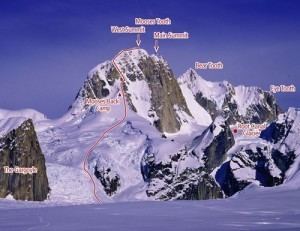Prominence 899 m Mountain range Alaska Range | Elevation 3,150 m First ascent June 1964 | |
 | ||
Easiest route Ham and Eggs: rock/snow/ice climb First ascenders Alfons Reichegger, Arnold Hasenkopf, Walter Welsch, Klaus Bierl Similar Mount Hunter, Mount Dickey, Mount Huntington, Mount Foraker, Denali | ||
The Moose's Tooth (or simply Moose's Tooth, Mooses Tooth) is a rock peak on the east side of the Ruth Gorge in the Central Alaska Range, 15 miles (24 km) southeast of Denali. Despite its relatively low elevation, it is a difficult climb. It is notable for its many large rock faces and its long ice couloirs, which are famous in mountaineering circles, and have seen a number of highly technical ascents.
Contents
Map of The Moose's Tooth, Alaska, USA
The peak was originally called Mount Hubbard after General Thomas Hamlin Hubbard — the president of the Peary Arctic Club — by Belmore Browne and Herschel Parker. This name was revoked by the United States Geological Survey, which named the peak "The Mooses Tooth," a translation of the Athabascan name for the peak. The official USGS name does lack the grammatically correct apostrophe.
The Moose's Tooth is located just to the east of the northern end of the Ruth Gorge, across from Mount Barille and Mount Dickey. It is the chief in a complex of rock peaks with names such as "Eye Tooth", "Sugar Tooth", and "Broken Tooth." On the east side of this complex lies the head of the Buckskin Glacier, which provides access to climbs on the particularly large and difficult east face of The Moose's Tooth.
The name of the peak comes from its structure: its summit ridge is a long, low angled ridge running roughly east-west for about a mile, with steep drops to the north and south. This gives the mountain a vague resemblance to a moose's tooth. It also makes climbing to the true (east) summit from the west ridge (the least technical route) very difficult. The summit is more normally reached by steep couloirs on the southwestern side of the peak.
The first ascent of The Moose's Tooth was in June, 1964, by four Germans, via the Northwest Ridge. In June, 1974, Gary Bocarde, Michael Clark, Charles Porter, and John Svenson climbed the lower Southwest Summit via the Southwest Face, for the second ascent of the massif, though not of the main summit. They found a great quantity of rotten rock. In July, 1975, Jon Krakauer, Thomas Davies, and Nate Zinsser made the second ascent of the main summit, via a couloir on the south face which they called the "Ham and Eggs Route." This is the most popular route on the mountain today.
